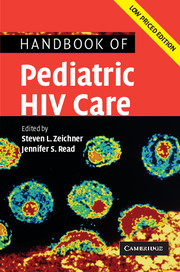Book contents
- Frontmatter
- Contents
- List of contributors
- List of abbreviations
- Foreword
- Preface
- Part I Scientific basis of pediatric HIV care
- Part II General issues in the care of pediatric HIV patients
- Part III Antiretroviral therapy
- Part IV Clinical manifestations of HIV infection in children
- Part V Infectious problems in pediatric HIV disease
- 30 Serious infections caused by typical bacteria
- 31 Tuberculosis
- 32 Disseminated Mycobacterium avium complex infection
- 33 Fungal infections
- 34 Herpesvirus infections
- 35 Pneumocystis jiroveci pneumonia
- Part VI Medical, social, and legal issues
- Appendix 1 Formulary of antiretroviral agents
- Appendix 2 National Institutes of Health sponsored clinical trials for pediatric HIV disease
- Appendix 3 Selected HIV-related internet resources
- Appendix 4 Selected legal resources for HIV-infected children
- Index
- References
34 - Herpesvirus infections
Published online by Cambridge University Press: 23 December 2009
- Frontmatter
- Contents
- List of contributors
- List of abbreviations
- Foreword
- Preface
- Part I Scientific basis of pediatric HIV care
- Part II General issues in the care of pediatric HIV patients
- Part III Antiretroviral therapy
- Part IV Clinical manifestations of HIV infection in children
- Part V Infectious problems in pediatric HIV disease
- 30 Serious infections caused by typical bacteria
- 31 Tuberculosis
- 32 Disseminated Mycobacterium avium complex infection
- 33 Fungal infections
- 34 Herpesvirus infections
- 35 Pneumocystis jiroveci pneumonia
- Part VI Medical, social, and legal issues
- Appendix 1 Formulary of antiretroviral agents
- Appendix 2 National Institutes of Health sponsored clinical trials for pediatric HIV disease
- Appendix 3 Selected HIV-related internet resources
- Appendix 4 Selected legal resources for HIV-infected children
- Index
- References
Summary
Introduction
Herpesviruses share a common structure: double-stranded DNA, surrounded by a protein capsid and a lipid and glycoprotein envelope. Primary infection typically occurs during childhood or early adult years. Beyond neonates, infection rarely results in serious illness in immunocompetent hosts. Herpesvirus infections are usually controlled by the cellular immune system (see Chapter 1): immunocompromised patients can develop serious, life-threatening herpesvirus infections. In normal hosts herpesviruses establish lifelong, latent infection, which may reactivate. Sites harboring latent infection are sensory autonomic ganglia, for herpes simplex virus (HSV) and varicella-zoster virus (VZV); for cytomegalovirus (CMV), Epstein–Barr virus (EBV) and human herpesvirus 6 (HHV-6), lymphocytes are latent reservoirs. A complex interplay exists between herpesviruses and HIV [1]. In some in vitro systems, infection with CMV or HSV may increase susceptibility of cells to HIV infection. In HIV-infected cells, infection with CMV or HSV can upregulate HIV expression. Co-infection with HIV and CMV enhances CMV replication.
In immunocompromised hosts, primary herpesviruse infections may be more severe than in healthy children. Reactivation infections occur more frequently and severely in HIV-infected children. CMV, HSV, VZV, and Epstein–Barr virus (EBV), HHV-6, and human herpesvirus-8 (HHV-8 or Kaposi's sarcoma-associated herpesvirus, KSHV) cause significant morbidity in HIV-infected individuals.
Cytomegalovirus (CMV)
Epidemiology
CMV is transmitted via blood, urine, saliva, tears, breast milk, stool, and genital secretions. CMV may be transmitted in utero, perinatally, or postnatally. In children, infection usually occurs through saliva or urine. In young adulthood, CMV seropositivity rates rise secondary to sexual activity.
- Type
- Chapter
- Information
- Handbook of Pediatric HIV Care , pp. 721 - 739Publisher: Cambridge University PressPrint publication year: 2006



